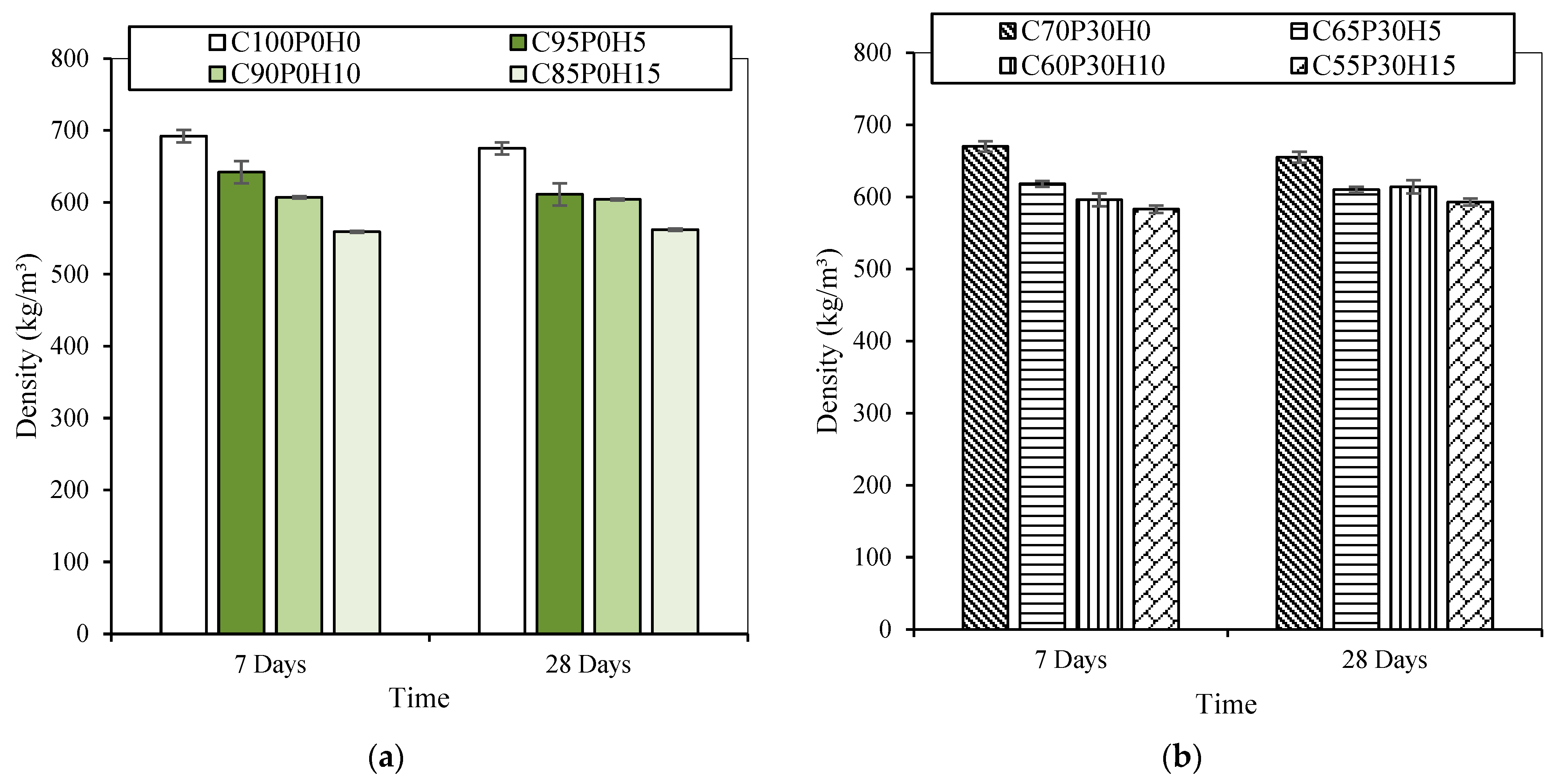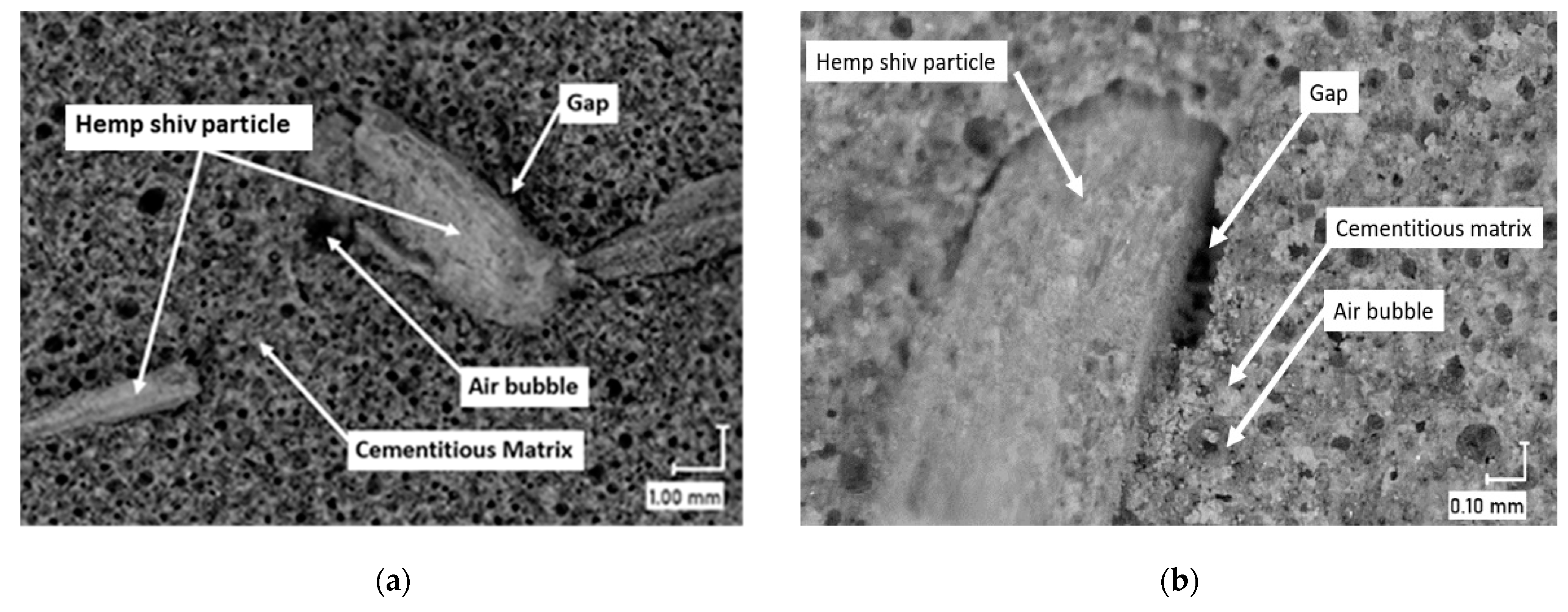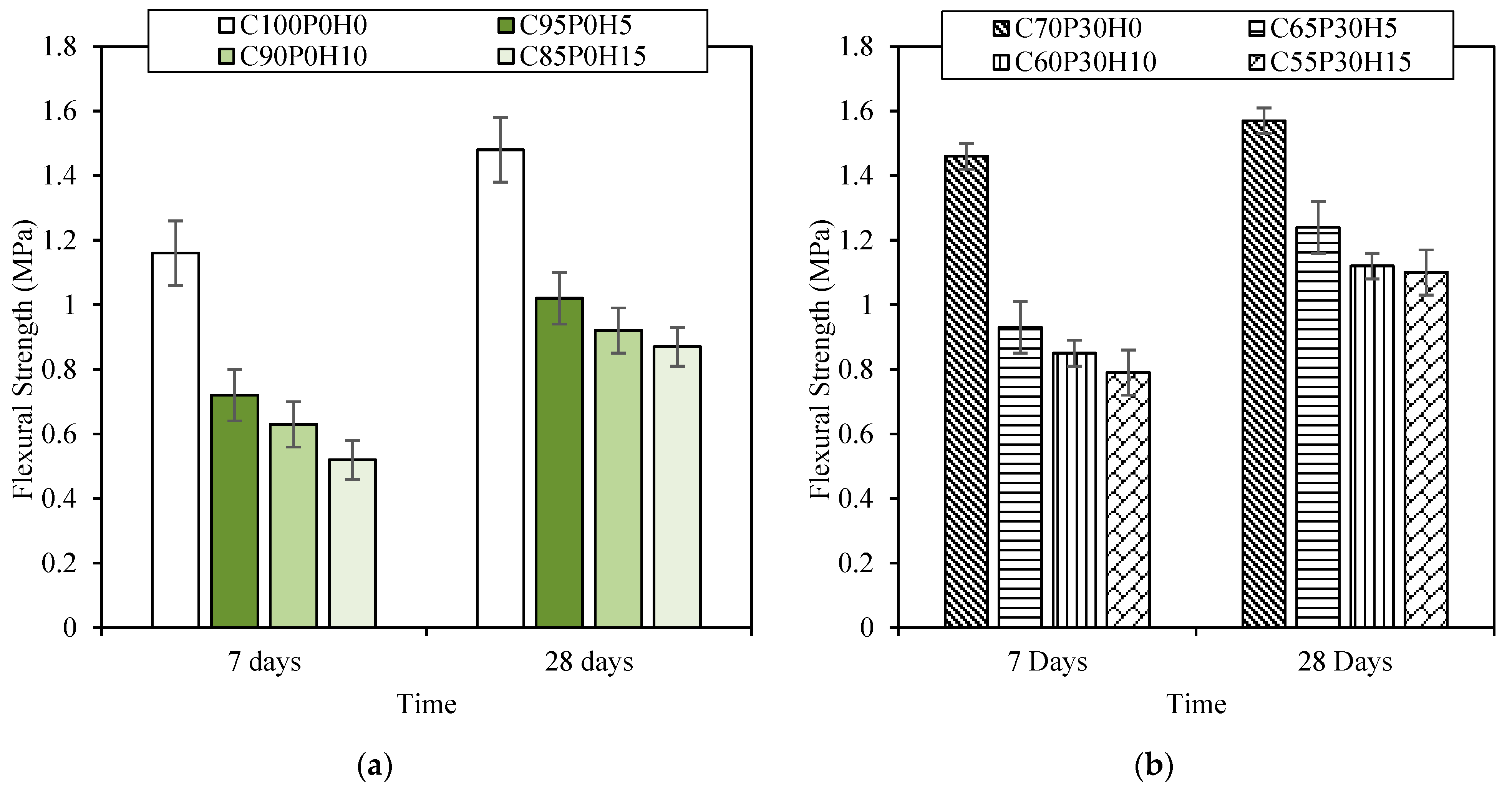Influence of Pozzolans and Hemp Shives on the Properties of Non-Autoclaved Foamed Concrete
Abstract
1. Introduction
2. Materials and Methods
2.1. Raw Materials
- Portland Cement CEM I 52.5N, in accordance with the EN 197-1 standard. The absolute density was 3100 kg·m−3 and the bulk density was 2200 kg·m−3.
- Ground Granulated Blast Furnace Slag, fulfilling EN 206-1, a by-product from iron production with an absolute density of 2900 kg·m−3.
- Metakaolin (MK) with an absolute density of 2600 kg·m−3, obtained by kaolinite flash calcination at approximately 700 °C, the presence of MK acted as an activator that neutralised the retarding effect of GGBFS at the early age of resistance development and improved resistance at later ages [13].
- Plant materials composed of 95% hemp shives and 5% hemp fibres. A characterisation of hemp shiv particles according to the recommendations of the RILEM TC 236 BBM Technical Committee was investigated [28]. Hemp shiv presented an absolute density of 1400 kg·m−3, bulk density of 140 kg·m−3, thermal conductivity of 0.048 Wm−1K−1 and hemp shiv particle size distribution ranging between 0.6 and 5 mm. Figure 1 shows the water absorption of hemp particles and shows that the maximum water absorption of hemp particles was approximately 247%.
2.2. Specimens Elaboration
2.3. Test Methods
3. Results and Discussion
3.1. Foamed Concrete Density
3.2. Mechanical Properties
3.3. Thermal Conductivity
3.4. Cost and CO2 Emissions Estimation
4. Conclusions
Author Contributions
Funding
Institutional Review Board Statement
Informed Consent Statement
Conflicts of Interest
Abbreviations
| FC | Foamed Concrete |
| BFC | Bio-based Foamed Concrete |
| HS | Hemp Shiv |
| HSC | Hemp Shiv Concrete |
| CEM I | CEM I 52.5N Ordinary Portland Cement |
| MK | Metakaolin |
| GGBFS | Ground Granulated Blast Furnace Slag |
| FA | Fly Ash |
| SP | Superplasticiser |
| Acc | Accelerator |
| FAG | Foaming Agent |
| Rc | Compressive strength |
| Rf | Flexural strength |
| C70-BFCs | The BFC of the C70H0 by-product |
| C100-BFCs | The BFC of the C100H0 by-product |
References
- Amran, Y.; Farzadnia, N.; Abang Ali, A.A. Properties and applications of foamed concrete; a review. Constr. Build. Mater. 2015, 101, 990–1005. [Google Scholar] [CrossRef]
- Ramamurthy, K.; Kunhanandan Nambiar, E.K.; Indu Siva Ranjani, G. A classification of studies on properties of foam concrete. Cem. Concr. Compos. 2009, 31, 388–396. [Google Scholar] [CrossRef]
- Kearsley, E.; Wainwright, P. Porosity and permeability of foamed concrete. Cem. Concr. Res. 2001, 31, 805–812. [Google Scholar] [CrossRef]
- Mohamad, N.; Omar, W.; Abdullah, R. Precast Lightweight Foamed Concrete Sandwich Panel (PLFP) Tested under Axial Load: Preliminary Results. Adv. Mater. Res. 2011, 250–253, 1153–1162. [Google Scholar] [CrossRef]
- Fabien, A.; Sebaibi, N.; Boutouil, M. Effect of several parameters on non-autoclaved aerated concrete: Use of recycling waste perlite. Eur. J. Environ. Civ. Eng. 2019, 26, 58–75. [Google Scholar] [CrossRef]
- Samson, G. Synthèse et Propriétés des Mousses Minérales, Phdthesis, INSA de Rennes. 2015. Available online: https://tel.archives-ouvertes.fr/tel-01275900 (accessed on 30 November 2020).
- Propriétés et Caractéristiques des Matériaux de Construction; Eco-Matériaux, Energie Grise et Bilan Carbone (4e Edition)-Yves Couasnet-Le Moniteur-Grand Format-Le Hall du Livre NANCY, n.d. Available online: https://halldulivre.com/livre/9782281143454-proprietes-et-caracteristiques-des-materiaux-de-construction-eco-materiaux-energie-grise-et-bilan-carbone-4e-edition-yves-couasnet/ (accessed on 13 November 2020).
- Williams, J.; Lawrence, M.; Walker, P. The influence of constituents on the properties of the bio-aggregate composite hemp-lime. Constr. Build. Mater. 2018, 159, 9–17. [Google Scholar] [CrossRef]
- De Silva, P.S.; Glasser, F.P. Phase relations in the system CaO☐Al2O3☐SiO2☐H2O relevant to metakaolin-calcium hydroxide hydration. Cem. Concr. Res. 1993, 23, 627–639. [Google Scholar] [CrossRef]
- Gruyaert, E.; Tittelboom, K.V.; Rahier, H.; Belie, N.D. Activation of Pozzolanic and Latent-Hydraulic Reactions by Alkalis in Order to Repair Concrete Cracks. J. Mater. Civ. Eng. 2015, 27, 04014208. [Google Scholar] [CrossRef]
- Frı, M.; Cabrera, J. Influence of MK on the reaction kinetics in MK/lime and MK-blended cement systems at 20 °C. Cem. Concr. Res. 2001, 31, 519–527. [Google Scholar] [CrossRef]
- Frı, M.; de Rojas, M.; Cabrera, J. The effect that the pozzolanic reaction of metakaolin has on the heat evolution in metakaolin-cement mortars. Cem. Concr. Res. 2000, 30, 209–216. [Google Scholar] [CrossRef]
- Mohd Nasir, N.A.; McCarthy, M. Effect of Metakaolin on early Strength of GGBS Ternary Concrete. Appl. Mech. Mater. 2014, 584–586, 1551–1557. [Google Scholar] [CrossRef]
- Jones, M.R.; McCarthy, A. Heat of hydration in foamed concrete: Effect of mix constituents and plastic density. Cem. Concr. Res. 2006, 36, 1032–1041. [Google Scholar] [CrossRef]
- Jitchaiyaphum, K.; Sinsiri, T.; Chindaprasirt, P. Cellular Lightweight Concrete Containing Pozzolan Materials. Procedia Eng. 2011, 14, 1157–1164. [Google Scholar] [CrossRef]
- Yang, L.; Yan, Y.; Hu, Z. Utilization of phosphogypsum for the preparation of non-autoclaved aerated concrete. Constr. Build. Mater. 2013, 44, 600–606. [Google Scholar] [CrossRef]
- Tian, T.; Yan, Y.; Hu, Z.; Xu, Y.; Chen, Y.; Shi, J. Utilization of original phosphogypsum for the preparation of foam concrete. Constr. Build. Mater. 2016, 115, 143–152. [Google Scholar] [CrossRef]
- Samson, G.; Cyr, M.; Gao, X. Thermomechanical performance of blended metakaolin-GGBS alkali-activated foam concrete. Constr. Build. Mater. 2017, 157, 982–993. [Google Scholar] [CrossRef]
- Samson, G.; Phelipot-Mardelé, A.; Lanos, C.; Baux, C. Influence du tensio-actif sur les propriétés des gypses cellulaires. In XXXème Rencontres de l’AUGC-IBPSA “Constructions Durables”; Materials Sciences: Chambéry, France, 2012; p. 10. Available online: https://hal.archives-ouvertes.fr/hal-00726506 (accessed on 31 October 2018).
- Sebaibi, N.; Khadraoui-Mehir, F.; Kourtaa, S.; Boutouil, M. Optimization of non-autoclaved aerated insulating foam using bio-based materials. Constr. Build. Mater. 2020, 262, 120822. [Google Scholar] [CrossRef]
- Tran Le, A.D. Etude des Transferts Hygrothermiques dans le Béton de Chanvre et leur Application au Bâtiment (Sous Titre: Simulation Numérique et Approche Expérimentale). 2010. Available online: https://theses.hal.science/tel-00590819/ (accessed on 2 February 2020).
- Chamoin, J. Optimisation des Propriétés (Physiques, Mécaniques et Hydriques) de Bétons de Chanvre par la Maîtrise de la Formulation; INSA: Rennes, France, 2013; Available online: http://www.theses.fr/2013ISAR0016 (accessed on 11 October 2018).
- Cerezo, V. Propriétés Mécaniques, Thermiques et Acoustiques d’un Matériau à Base de Particules Végétales: Approche Expérimentale et Modélisation Théorique; Institut National des Sciences Appliquées: Lyon, France, 2005. [Google Scholar]
- Nozahic, V. Vers une Nouvelle Démarche de Conception des Bétons de Végétaux Lignocellulosiques Basée sur la Compréhension et L’amélioration de L’interface liant/végétal: Application à Des Granulats de Chenevotte et de tige de Tournesol Associés à un Liant Ponce/Chaux, These de Doctorat, Clermont-Ferrand 2. 2012. Available online: http://www.theses.fr/2012CLF22265 (accessed on 27 April 2021).
- Evrard, A. Transient Hygrothermal Behavior of Lime-Hemp Materials; Université catholique de Louvain: Ottignies-Louvain-la-Neuve, Belgique, 2008. [Google Scholar]
- Huyen, B.T.; Sebaibi, N.; Boutouil, M.; Levacher, D. Determination and Review of Physical and Mechanical Properties of Raw and Treated Coconut Fibers for Their Recycling in Construction Materials. Fibers 2020, 8, 37. [Google Scholar] [CrossRef]
- Huyen, B.T.; Boutouil, M.; Levacher, D.; Sebaibi, N. Evaluation of the influence of accelerated carbonation on the microstructure and mechanical characteristics of coconut fibre-reinforced cementitious matrix. J. Build. Eng. 2021, 39, 102269. [Google Scholar] [CrossRef]
- Amziane, S.; Collet, F.; Lawrence, M.; Magniont, C.; Picandet, V.; Sonebi, M. Recommendation of the RILEM TC 236-BBM: Characterisation Testing of Hemp Shiv to Determine the Initial Water Content, Water Absorption, Dry Density, Particle Size Distribution and Thermal Conductivity. Mater. Struct. 2017, 50, 167. [Google Scholar] [CrossRef]
- Ezziane, K.; Bougara, A.; Kadri, A.; Khelafi, H.; Kadri, E. Compressive strength of mortar containing natural pozzolan under various curing temperature. Cem. Concr. Compos. 2007, 29, 587–593. [Google Scholar] [CrossRef]
- Diquelou, Y.; Gourlay, E.; Arnaud, L.; Kurek, B. Impact of hemp shiv on cement setting and hardening: Influence of the extracted components from the aggregates and study of the interfaces with the inorganic matrix. Cem. Concr. Compos. 2015, 55, 112–121. [Google Scholar] [CrossRef]
- Jacquemot, F. Développement D’une Gamme de Béton Ultra Léger: THERMOLITYS®; Cerib: Épernon, France, 2015. [Google Scholar]
- Hustache, Y.; Arnaud, L. Synthèse des Connaissances sur les Bétons et Mortiers de Chanvre-PDF Téléchargement Gratuit. 2008. Available online: https://docplayer.fr/53129567-Synthese-des-connaissances-sur-les-betons-et-mortiers-de-chanvre.html (accessed on 26 April 2021).
- Nguyen, T. Contribution à L’étude de la Formulation et du Procédé de Fabrication D’éléments de Construction en Béton de Chanvre. Ph.D. Thesis, Université de Bretagne Sud, Lorient, France, 2010. [Google Scholar]
- Page, J.; Amziane, S.; Sonebi, M. Effet d’un adjuvant viscosant sur les propriétés du béton de chanvre. In Proceedings of the Conférence Internationale NoMaD, Douai, France, 5–6 November 2015. [Google Scholar]
- Kearsley, E.; Wainwright, P. The effect of porosity on the strength of foamed concrete. Cem. Concr. Res. 2002, 32, 233–239. [Google Scholar] [CrossRef]
- Kearsley, E.; Mostert, D. Designing mix composition of foamed concrete with high fly ash contents. In Proceedings of the International Conference on the Use of Foamed Concrete in Construction, Scotland, UK, 5 July 2005; pp. 29–36. [Google Scholar]
- Page, J.; Boutouil, M.; Khadraoui, F.; Moussa, G. Etude des propriétés mécaniques d’un béton renforcé par des fibres de lin. In Proceedings of the Conférence Internationale Francophone NoMaD, Mines Douai, France; Douai, France, 5–6 November 2015. [Google Scholar]
- Kriker, A.; Debicki, G.; Bali, A.; Khenfer, M.; Chabannet, M. Mechanical properties of date palm fibres and concrete reinforced with date palm fibres in hot-dry climate. Cem. Concr. Compos. 2005, 27, 554–564. [Google Scholar] [CrossRef]
- Sawsen, C.; Fouzia, K.; Mohamed, B.; Moussa, G. Optimizing the formulation of flax fiber-reinforced cement composites. Constr. Build. Mater. 2014, 54, 659–664. [Google Scholar] [CrossRef]
- Diquélou, Y.; Gourlay, E.; Arnaud, L.; Kurek, B. Influence of binder characteristics on the setting and hardening of hemp lightweight concrete. Constr. Build. Mater. 2016, 112, 506–517. [Google Scholar] [CrossRef]
- Namsone, E.; Šahmenko, G.; Korjakins, A. Durability Properties of High Performance Foamed Concrete. Procedia Eng. 2017, 172, 760–767. [Google Scholar] [CrossRef]
- ALaborel-Préneron, A.; Aubert, J.-E.; Magniont, C.; Maillard, P.; Poirier, C. Effect of Plant Aggregates on Mechanical Properties of Earth Bricks. J. Mater. Civ. Eng. 2017, 29. [Google Scholar] [CrossRef]
- Hamad, A. Materials, Production, Properties and Application of Aerated Lightweight Concrete: Review. Int. J. Mater. Sci. Eng. 2014, 2, 125–157. [Google Scholar] [CrossRef]
- Zhang, X.; Yang, Q.; Shi, Y.; Zheng, G.; Li, Q.; Chen, H.; Cheng, X. Effects of different control methods on the mechanical and thermal properties of ultra-light foamed concrete. Constr. Build. Mater. 2020, 262, 120082. [Google Scholar] [CrossRef]
- Morozov, M.; Strizhak, P. Investigation of energy efficiency of innovate thermal insulating materials and their influence on the building heat regime. MATEC Web Conf. 2015, 23, 01025. [Google Scholar] [CrossRef]
- Douaissia, Z.; Merzoud, M.; Habita, M.; Benazzouk, A. Effets Du Laitier Granulé et de La Pouzzolane Naturelle Sur Les Propriétés Physico-Mécaniques et Sur La Réaction Alcali Silice Des Mortiers à Base de Verre Recyclé. Synthèse Rev. Sci. Technol. 2020, 26, 78–91. [Google Scholar]
- Alsalman, A.; Assi, L.; Kareem, R.; Carter, K.; Ziehl, P. Energy and CO2 emission assessments of alkali-activated concrete and Ordinary Portland Cement concrete: A comparative analysis of different grades of concrete. Clean. Environ. Syst. 2021, 3, 100047. [Google Scholar] [CrossRef]






| The Chemical Compound | Chemical Composition (%) | ||
|---|---|---|---|
| CEM I | GGBFS | MK | |
| Calcium oxide (CaO) | 64.17 | 38.6 | 0.2 |
| Aluminium oxide (Al2O3) | 4.44 | 12.3 | 24.1 |
| Silicon dioxide (SiO2) | 19.6 | 36.9 | 68.1 |
| Ferric oxide (Fe2O3) | 4 | 0.3 | 3.7 |
| Sulphur trioxide (SO3) | 2.6 | 2.1 | - |
| Sodium oxide (Na2O) | 0.07 | - | 0.1 |
| Magnesium oxide (MgO) | 1.25 | 7.5 | 0.2 |
| Potassium oxide (K2O) | 0.84 | - | 0.4 |
| Others | 3.03 | 2.3 | 3.2 |
| Acc | SP | FAG | |
|---|---|---|---|
| Consistency | Liquid | Liquid | Liquid |
| Colour | Yellow | Brown | Bright yellow |
| Density (g/cm3) | 1.45 ± 0.01 | 1.05 ± 0.01 | 1.04 ± 0.02 |
| Recommended dose * | 1–1.5% | 1–3% | - |
| Chlorides content | ≤0.1% | ≤0.1% | 0.001% |
| pH | 6 ± 1 | 6 ± 1 | 9 |
| Solids Content (%) | 61.5% ± 2.7% | 30.5% ± 1.5% | 30% |
| Names of Mixes | Fresh Density (kg/m3) | Composition of Mixture (kg/m3) | Wt/B | Wb/B | ||||||||
|---|---|---|---|---|---|---|---|---|---|---|---|---|
| C | GGBFS | MK | HS | SP | Acc | FAG | Wh | Wt | ||||
| C100P0H0 * | 891 | 700 | - | - | - | 14 | 7 | 2.1 | 0.00 | 168.00 | 0.24 | 0.24 |
| C70P30H0 | 933 | 490 | 140 | 70 | - | 7 | 7 | 2.1 | 0.00 | 217.00 | 0.31 | 0.31 |
| C95P0H5 | 858 | 665 | - | - | 2.2 | 14 | 7 | 2.1 | 5.57 | 165.17 | 0.25 | 0.24 |
| C65P30H5 | 900 | 455 | 140 | 70 | 2.2 | 7 | 7 | 2.1 | 5.57 | 211.72 | 0.32 | 0.31 |
| C90P0H10 | 825 | 630 | - | - | 4.5 | 14 | 7 | 2.1 | 11.14 | 162.34 | 0.26 | 0.24 |
| C60P30H10 | 867 | 420 | 140 | 70 | 4.5 | 7 | 7 | 2.1 | 11.14 | 206.44 | 0.33 | 0.31 |
| C85P0H15 | 792 | 595 | - | - | 6.7 | 14 | 7 | 2.1 | 16.70 | 159.50 | 0.27 | 0.24 |
| C55P30H15 | 834 | 385 | 140 | 70 | 6.7 | 7 | 7 | 2.1 | 16.7 | 201.95 | 0.34 | 0.31 |
| Rating | Thermal Conductivity (Wm−1K−1) | Compressive Strength (MPa) | Cost (€/m3) | CO2 Emissions (kg CO2/m3) |
|---|---|---|---|---|
| 0 | >0.2 | 0–1 | >400 | >600 |
| 1 | 0.175–0.2 | 1–2 | 300–400 | 500–600 |
| 2 | 0.15–0.175 | 2–3 | 200–300 | 400–500 |
| 3 | 0.125–0.15 | 3–4 | 100–200 | 300–400 |
| 4 | 0.1–0.125 | >4 | 0–100 | 0–300 |
| Names of Mixes | Cost (€/m3) | CO2 Emissions (kg CO2/m3) | Ranking | |||||
|---|---|---|---|---|---|---|---|---|
| Thermal Conductivity | Compressive Strength—28 days | CO2 | Cost | Score b | Global Rank c | |||
| Weight a = 4 | 3 | 2 | 1 | |||||
| C100P0H0 | 259 | 665 | 1 | 4 | 0 | 2 | 18 | 7 |
| C70P30H0 | 225 | 484 | 3 | 4 | 2 | 2 | 30 | 1 |
| C95P0H5 | 249 | 632 | 2 | 2 | 0 | 2 | 16 | 8 |
| C65P30H5 | 215 | 451 | 3 | 3 | 2 | 2 | 27 | 3 |
| C90P0H10 | 239 | 599 | 3 | 1 | 1 | 2 | 19 | 5 |
| C60P30H10 | 205 | 417 | 3 | 2 | 2 | 2 | 24 | 4 |
| C85P0H15 | 229 | 565 | 3 | 1 | 1 | 2 | 19 | 5 |
| C55P30H15 | 195 | 384 | 3 | 3 | 3 | 3 | 30 | 1 |
Disclaimer/Publisher’s Note: The statements, opinions and data contained in all publications are solely those of the individual author(s) and contributor(s) and not of MDPI and/or the editor(s). MDPI and/or the editor(s) disclaim responsibility for any injury to people or property resulting from any ideas, methods, instructions or products referred to in the content. |
© 2023 by the authors. Licensee MDPI, Basel, Switzerland. This article is an open access article distributed under the terms and conditions of the Creative Commons Attribution (CC BY) license (https://creativecommons.org/licenses/by/4.0/).
Share and Cite
Mohamad, A.; Khadraoui, F.; Boutouil, M.; Chateigner, D. Influence of Pozzolans and Hemp Shives on the Properties of Non-Autoclaved Foamed Concrete. Materials 2023, 16, 591. https://doi.org/10.3390/ma16020591
Mohamad A, Khadraoui F, Boutouil M, Chateigner D. Influence of Pozzolans and Hemp Shives on the Properties of Non-Autoclaved Foamed Concrete. Materials. 2023; 16(2):591. https://doi.org/10.3390/ma16020591
Chicago/Turabian StyleMohamad, Abdelrahman, Fouzia Khadraoui, Mohamed Boutouil, and Daniel Chateigner. 2023. "Influence of Pozzolans and Hemp Shives on the Properties of Non-Autoclaved Foamed Concrete" Materials 16, no. 2: 591. https://doi.org/10.3390/ma16020591
APA StyleMohamad, A., Khadraoui, F., Boutouil, M., & Chateigner, D. (2023). Influence of Pozzolans and Hemp Shives on the Properties of Non-Autoclaved Foamed Concrete. Materials, 16(2), 591. https://doi.org/10.3390/ma16020591








